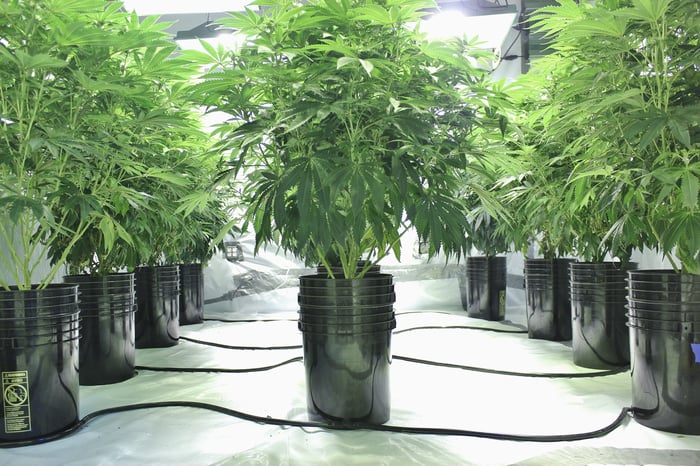Exactly two months from today, what had once seemed impossible will become a reality. On Oct. 17, 2018, recreational marijuana will go on sale in our neighbor to the north, making Canada the first industrialized country in the world to legalize adult-use weed.
As you can probably imagine, legalizing pot is expected to yield some potentially huge dollar figures for the industry and hopefully for investors who've placed their hard-earned money into marijuana stocks, as well. Though estimates vary wildly -- as would be expected since no developed country has done what Canada is doing -- the legal weed industry could net in the neighborhood of $5 billion in added annual sales. But where these sales will wind up is what remains the great mystery.

Image source: Getty Images.
Which pot stocks will generate the most revenue next year?
With this in mind, I took a gander at Wall Street's consensus revenue estimates for more than a dozen pure-play pot stocks -- i.e., companies that derive all or nearly all of their sales from the sale of cannabis or cannabis-derived drugs -- to get a feel for where these dollars would be flowing. Ultimately, five marijuana companies are expected by Wall Street to deliver at least $124 million in revenue next year.
Understandably, the data is far from perfect. For example, a number of marijuana stocks tend to have different starts to their fiscal years, which makes apples-to-apples sales comparisons difficult, if not impossible.
Additionally, some of the biggest names in the industry have yet to receive coverage from Wall Street. Both The Green Organic Dutchman and Tilray somewhat recently went public, and both are expected to be major players in terms of peak cannabis production. However, because both have recently gone public, Wall Street hasn't laid out sales and profit expectations as of yet. Thus, both companies, along with a number of other mid-tier growers, weren't included.
Keeping these limitations in mind, here are the five marijuana stocks with the highest expected sales next year.

Image source: Getty Images.
Canopy Growth Corp.: $687.8 million
Perhaps it's no surprise that Canopy Growth Corp. (CGC -3.13%), the largest marijuana stock by market cap, also has the highest expected sales next year, according to Wall Street. But as noted, Canopy Growth operates on a different fiscal year than most of its peers, so this projection is for its fiscal 2020.
Canopy Growth has two factors working in its favor. First, it has 5.6 million square feet of production capacity that it expects to have licensed in British Columbia in the not-so-distant future. Health Canada has already given the green light to 2.4 million square feet of production space, which should give the company more than ample capacity to nab significant recreational market share when the green flag waves in two months' time.
Canopy Growth also has the most recognizable cannabis brand throughout Canada, Tweed. With pot stocks now turning their attention to brand building, Canopy appears to have a step up on its competition.

Image source: Getty Images.
Aphria: $356.6 million
Though you might have expected to see a different company in the No. 2 slot, Aphria (NASDAQOTH: APHQF) is expected to deliver more than $356 million in sales by fiscal 2019. This healthy revenue total is expected to derive from two key projects hitting their completion dates in January 2019.
The first project, Aphria One, is the company's flagship organic build-out. This four-phase expansion is costing Aphria in excess of $100 million but will eventually span about 1 million square feet of production capacity and yield around 100,000 kilograms.
The second project is known as Aphria Diamond and involves a joint venture between Aphria and Double Diamond Farms. Aphria is in the process of retrofitting vegetable-growing greenhouses for cannabis production, which saves a lot of time and money as opposed to building a new greenhouse from the ground up. When complete, this 1.2-million-square-foot facility should yield around 120,000 kilograms annually.

Image source: Getty Images.
Aurora Cannabis: $343.5 million
Perhaps the most surprising spot on this list belongs to Aurora Cannabis (ACB -1.86%), a company that, through organic build-outs, partnerships, and acquisitions, looks to be on track to produce more cannabis a year than any other grower (570,000 kilograms).
So why isn't it the No. 1 cannabis company in terms of expected revenue next year? It very well could be as simple as the different start times for fiscal years between Canopy Growth and Aurora. If we strictly compared fiscal 2019s, then Aurora has the edge over Canopy Growth. However, Canopy has already moved onto its fiscal 2019, whereas Aurora Cannabis has not.
Comparison aside, what should be interesting is how Aurora's margins hold up, given its announced focus on the medical cannabis market. Though the recreational weed market has a much larger patient pool, medical patients should present with better long-term margins, given their desired use for high-margin alternative cannabis products, such as oils. Assuming Aurora Cannabis devotes a notable portion of its production to alternative products and exports to foreign markets, it should have a genuine opportunity to make its revenue stretch further than its peers.

Image source: GW Pharmaceuticals.
GW Pharmaceuticals: $152.2 million
The only non-grower on this list is cannabinoid-based drug developer GW Pharmaceuticals (GWPH). Sales for the company are expected to catapult from just $19.2 million in 2018 to $152.2 million next year.
The big catalyst for GW Pharmaceuticals was the approval of cannabidiol-based drug Epidiolex on June 25 by the U.S. Food and Drug Administration (FDA). This therapy, which is the first cannabis-derived drug to get the green light from the FDA, is designed to treat two rare types of childhood-onset epilepsy known as Dravet syndrome and Lennox-Gastaut syndrome. Since there were no other FDA-approved treatments for Dravet syndrome prior to this approval, GW Pharmaceuticals looks to have a clear path to success.
Of course, things are rarely this easy for any drug developer. Even though the company has what looks like a clear path to launch out of the gate, competition from Zogenix could be right around the corner in Dravet syndrome. It remains to be seen how well a cannabis-derived drug can hold up against a more traditional pharmaceutical product if Zogenix's lead drug is approved by the FDA.

Image source: Getty Images.
CannTrust Holdings: $124.4 million
Last but not least, grower CannTrust Holdings (CNTTQ) is expected to generate a little over $124 million in sales next year.
The primary growth driver for CannTrust is the expansion of its Niagara greenhouse facility. At the end of June, the company announced the official opening of 450,000 square feet of hydroponic growing capacity, with another 600,000 square feet on the way. When the greenhouse is operating at full capacity, more than 100,000 kilograms of annual yield is expected.
What's particularly intriguing about CannTrust, other than its focus on alternative pot products, is its development of a perpetual harvesting system that moves containerized benches at its Niagara facility. In less fancy terminology, it means steadier crop production and harvesting. This harvesting system should help keep CannTrust's growing costs well below its peers.





